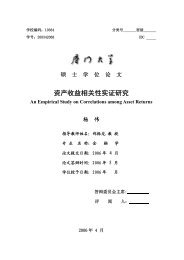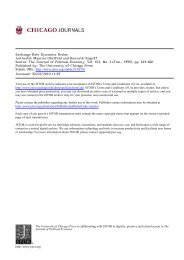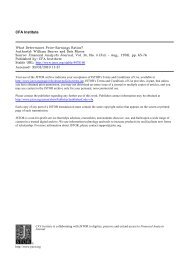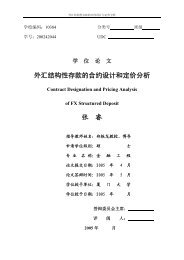The Term Structure of Interest Rates
The Term Structure of Interest Rates
The Term Structure of Interest Rates
You also want an ePaper? Increase the reach of your titles
YUMPU automatically turns print PDFs into web optimized ePapers that Google loves.
THE TERM STRUCTURE OF INTEREST RATES 517<br />
based upon correctly informed speculative activity might have the<br />
tw<strong>of</strong>old result <strong>of</strong> delaying an appropriate adjustment in yields and<br />
contributing directly to the pr<strong>of</strong>its <strong>of</strong> the speculators.<br />
3. Our experience has been that, except under the special conditions<br />
<strong>of</strong> the 1930's, debt markets have been generally free <strong>of</strong> panic<br />
reaction and excessive and self-feeding instability - though in the<br />
early postwar period many feared that such behavior would develop.<br />
Our recent experience reinforces the view that debt markets have<br />
the necessary adaptability and resilience to adjust effectively to<br />
changes in economic conditions and in active anticyclical monetary<br />
and debt management policies.<br />
4. Among the factors that can cause changes in the term structure<br />
<strong>of</strong> rates are shifts in the liquidity premiums reflected in the rate<br />
structure. <strong>The</strong>se may result from changes in the maturity structure<br />
<strong>of</strong> available debt, from other factors affecting the liquidity structure<br />
<strong>of</strong> the stock <strong>of</strong> investment assets, or from changes in investor attitudes<br />
toward liquidity. Properly interpreted, thus, the behavior <strong>of</strong><br />
the interest rate structure can be one indication <strong>of</strong> the liquidity<br />
situation <strong>of</strong> the economy, which, together with other evidence, can<br />
help to guide the conduct <strong>of</strong> monetary and debt management policies<br />
in maintaining liquidity conditions suited to the needs <strong>of</strong> economic<br />
stabilization. In particular, abnormally low yields on liquid<br />
short-term debt during a depression may be an indication that the<br />
economy is starved for liquidity, and abnormally high yields on such<br />
debt during prosperity may indicate that the supply <strong>of</strong> liquidity<br />
instruments is excessive for the conditions <strong>of</strong> the times.<br />
5. If used actively in a co-ordinated manner, monetary and<br />
debt management policies can play an essential role in dealing with<br />
both inflationary and deflationary problems, by enforcing an appropriate<br />
behavior <strong>of</strong> interest rates, through their impact upon conditions<br />
in debt markets, and through their influence upon the liquidity<br />
position <strong>of</strong> the economy.<br />
J. M. CULBERTSON.<br />
SCHOOL OF COMMERCE<br />
UNIVERSITY OF WISCONSIN

















